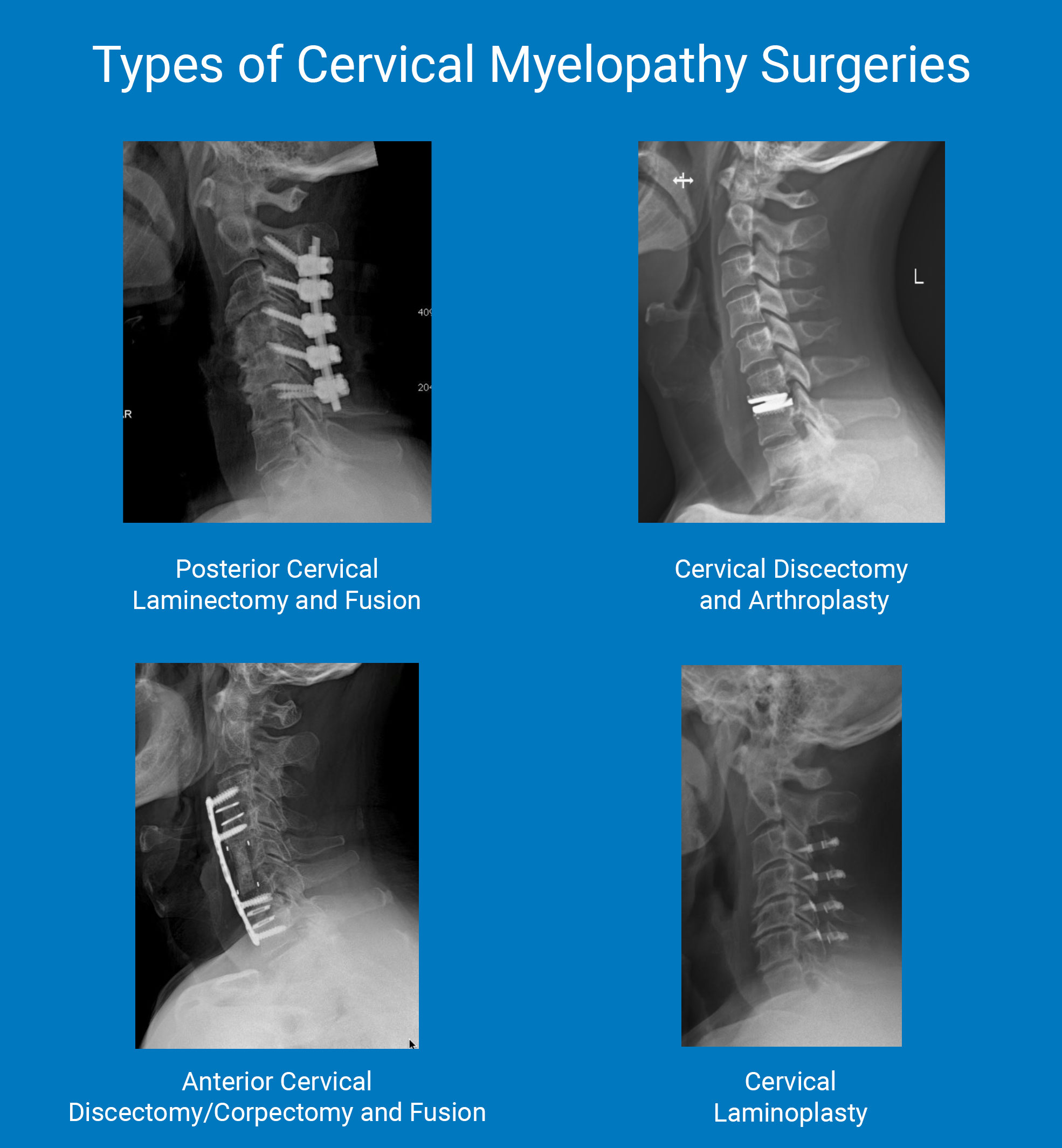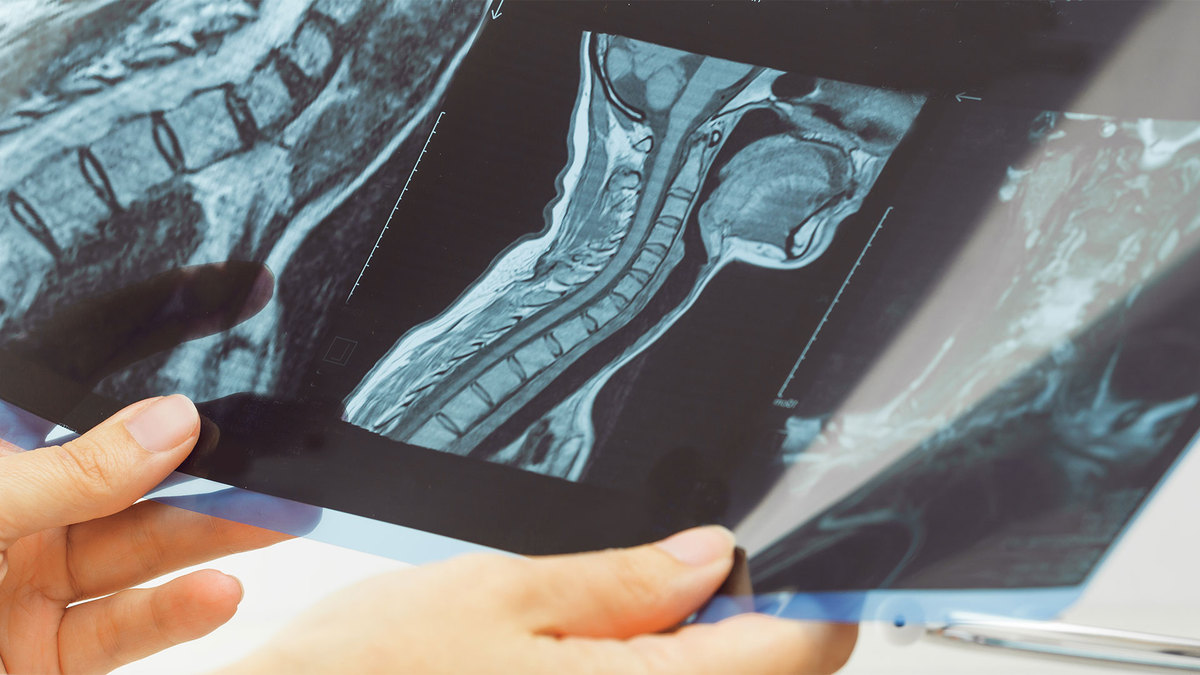Cervical Myelopathy Explained
What is Cervical Myelopathy?
Cervical myelopathy is the clinical term used to describe symptoms related to problems of the spinal cord within the neck.
The neck, or cervical spine, is made up of bones, vertebrae, stacked on top of each other. The vertebrae are connected by ligaments and joints. An opening through the center of the vertebrae is known as the spinal canal. The spinal cord travels through the spinal canal.
Degeneration of the spine is a natural process of aging. Like any other joint, the joints of the cervical spine can “wear out”. Spondylosis is the medical term used to describe these age-related changes. These degenerative changes can lead to neck pain. More concerning is when these changes lead to pressure on the spinal cord. Bone spurs and bulging discs project into the nerve channels, pressing on the spinal cord and nerves. This pressure can compromise the function of the spinal cord and cause symptoms of a cervical myelopathy.
The clinical term used to describe these symptoms is known as Cervical Spondylotic Myelopathy. This is the most common cause of spinal cord problems.
What are the Symptoms of Cervical Myelopathy?
Pressure on the spinal cord compresses the nerves and decreases the spinal cord blood supply. This compromises the ability of the spinal cord to transmit information resulting in the following complaints:
- Numbness/tingling of the arms and legs
- Loss of hand coordination
- Balance problems/walking difficulty
- Sense of urinary urgency
Patients are often surprised to learn that cervical myelopathy does not have to be associated with neck pain.
The urgency of treatment for cervical myelopathy depends on:
- How quickly have symptoms developed
- The severity of the symptoms
- How long have the symptoms existed
It's time to get back to doing what you love.
Cervical Myelopathy Treatments
The nonsurgical treatments of cervical spondylotic myelopathy are limited. For neck pain, your doctor may recommend nonsurgical treatments, such as physical therapy, pain medicine, and injections. Unfortunately, once symptoms develop from pressure on the spinal cord, these nonsurgical treatments provide less benefit. For symptoms related to spinal cord compression, spine surgery is often required. Cervical myelopathy surgery relieves pressure on the spinal cord.
How is Cervical Myelopathy Diagnosed?
Diagnosing cervical myelopathy requires a detailed neurological history and exam. It is essential that patients are evaluated by a doctor with experience in identifying and treating spinal cord compression.
The patient’s presentation needs to be correlated with findings on imaging of the cervical spine. Magnetic Resonance Imaging (MRI), is the most common imaging technique to identify pressure on the spinal cord. You may also receive a computed tomography (CT) scan to better define the bones of the cervical spine as well as X-rays, to define the mechanics of the cervical spine.
Surgery for Cervical Myelopathy
There are a variety of surgical procedures to treat cervical myelopathy from degenerative changes of the cervical spine. It is important to remember that there is no standard surgical procedure to address pressure on the spinal cord.
Some of the more common surgical treatments to relieve pressure on the spinal cord include:
- Anterior cervical discectomy and fusion
- Anterior cervical discectomy and arthroplasty
- Cervical laminoplasty
- Cervical laminectomy and fusion
Anterior cervical procedures are performed from the front of the neck. The disc and portions of the vertebrae are removed to relieve pressure on the spinal cord. The cervical spine is then rebuilt to maintain support and avoid neck pain. A fusion connects two cervical vertebrae while an arthroplasty is a mechanical device that imitates normal cervical spine movement.
Cervical laminoplasty and laminectomy/fusion are performed from the back of the cervical spine. The lamina, or bony roof of the spinal canal, are either removed (cervical laminectomy) or repositioned (laminoplasty). As with the anterior cervical procedures, a fusion will connect spinal bones while movement is maintained with a laminoplasty.
There are pros and cons with each of these surgical procedures. Your doctor may recommend one spine surgery versus another based on a careful clinical assessment and evaluation of your imaging.

Life After Cervical Myelopathy Surgery
All of these surgical procedures are generally well tolerated and effective at relieving pressure on the spinal cord.
For a period after surgery, patients may require pain medicine. After a month or two, physical therapy may be useful to address any neck stiffness or discomfort. Physical therapy is also useful to address any loss of neurological function from weakness or walking problems. Unfortunately, some symptoms may remain after surgery since the spinal cord has a limited capacity to heal.
Most patients will be able to return to their normal activities several months after spine surgery.
If you or your doctor think you suffer from cervical myelopathy, it is very important to see an experienced spine surgeon with expertise in treating spinal cord compression. The surgeons of Neurosurgeons of New Jersey are nationally recognized in the surgical treatment of spinal cord compression.

About Dr. Michael G. Kaiser
Dr. Michael G. Kaiser is a nationally recognized neurosurgeon in North Jersey and is a proud member of Neurosurgeons of New Jersey, practicing out of their Ridgewood office conveniently located on East Ridgewood Avenue. Dr. Kaiser specializes in complex and minimally invasive spine surgeries.






